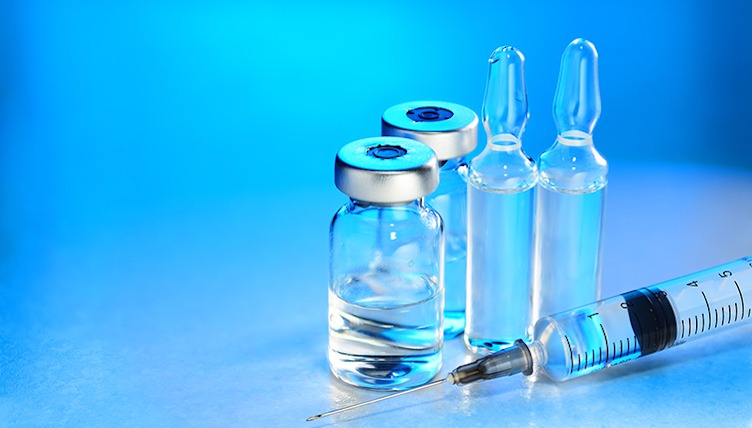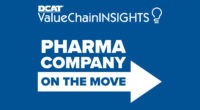COVID-19 and Vaccines: Operation Warp Speed
Operation Warp Speed, a US government initiative to accelerate development of 14 promising vaccine candidates against COVID-19, was launched last week (May 15, 2020). What is behind the initiative, and how does it fit with other international projects?
Inside Operation Warp Speed
The US government launched a national initiative, Operation Warp Speed, to accelerate the development of a vaccine and other medical countermeasures against the novel coronavirus (COVID-19). Among its other objectives, Operation Warp Speed aims to have substantial quantities of a safe and effective vaccine available by January 2021.
Operation Warp Speed is a public–private partnership to facilitate the development, manufacturing, and distribution of COVID-19 countermeasures, between components of the US Department of Health and Human Services (HHS), including the Centers for Disease Control and Prevention (CDC), the US Food and Drug Administration (FDA), the National Institutes of Health (NIH), and the Biomedical Advanced Research and Development Authority (BARDA); the Department of Defense; private firms; and other federal agencies, including the Department of Agriculture, the Department of Energy, and the Department of Veterans Affairs. It will coordinate existing HHS-wide efforts, including the NIH’s ACTIV partnership for vaccine and therapeutic development, NIH’s RADx initiative for diagnostic development, and work by BARDA.
Operation Warp Speed is headed by Moncef Slaoui, formerly, Chairman of Global Research and Development and Chairman of Global Vaccines at GlaxoSmithKline (GSK), where he led the development of five major novel vaccines and currently Partner at Medicxi Venture Capital and Chairman of the Board at Galvani, a bioelectronics R&D company jointly owned by GSK and Verily Life Sciences. Dr. Slaoui will serve as chief advisor and is joined in a leadership role by General Gustave F. Perna, who will serve as chief operating officer of Operation Warp Speed. As the four-star general in charge of the US Army Materiel Command, General Perna oversees the global supply chain and installation and materiel readiness for the US Army, including more than 190,000 military, civilian, and contract employees.
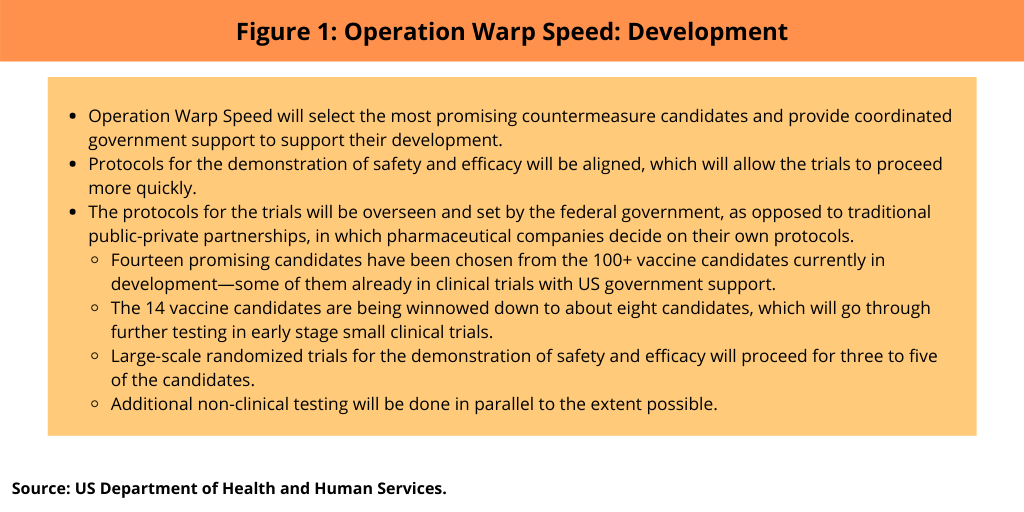
In addition to Dr. Slaoui and General Perna, each countermeasure area (vaccines, therapeutics, and diagnostics) will be overseen by a career HHS scientist. Serving a leadership role in vaccines is Peter Marks, MD, PhD., Director of the FDA’s Center for Biologics Evaluation and Research; in therapeutics is Janet Woodcock, MD, Director of the FDA’s Center for Drug Evaluation and Research; and in diagnostics is Bruce Tromberg, PhD, Director of the NIH’s National Institute of Biomedical Imaging and Bioengineering.
In addition, the US Department of Defense (DoD) has identified subject-matter experts to lead DoD support for five areas (diagnostics, therapeutics, vaccines, production and distribution, and security assistance). These leadership positions will be served as follows: (1) diagnostics—Major General Lee Payne, Assistant Director for Combat Support at the Defense Health Agency (DHA); (2) therapeutics—Sean Biggerstaff, PhD, Acting Director for Research and Development at DHA; (3) vaccines—Matt Hepburn, MD, Joint Project Lead CBRN Defense Enabling Biotechnologies; (4) production and distribution—Stacy Cummings, Principal Deputy Assistant Secretary of Defense for Acquisition Enablers; and (5) security and assistance—Andrew Kilianski, Chief Intelligence Officer for CBRN Defense.
In terms of funding, Congress has directed almost $10 billion to this effort through supplemental funding, including the CARES Act, and Congress has appropriated other flexible funding. Over $6.5 billion has been designated by Congress for countermeasure development through BARDA, along with $3 billion for NIH research.
The three focus areas of Operation Warp Speed
Operation Warp Speed will have three core areas of focus to accelerate the timeframe for countermeasures, including a vaccine: (1) development, (2) manufacturing, and (3) distribution (see Figures 1–3 ) and as outlined below.
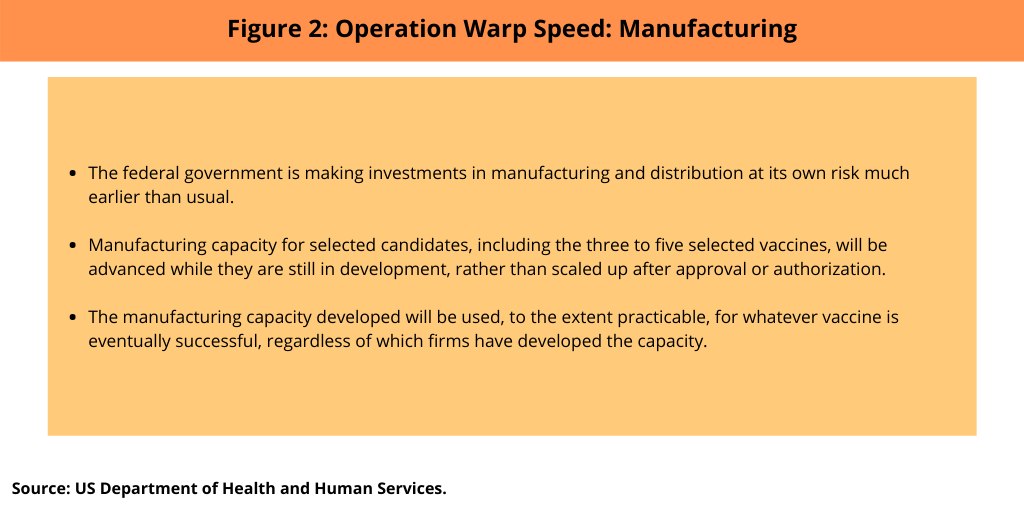
In terms of development (see Figure 1), Operation Warp Speed will select the most promising countermeasure candidates and provide coordinated government support to support their development. Protocols for the demonstration of safety and efficacy will be aligned, which will allow the trials to proceed more quickly, according to information from the HHS. The protocols for the trials will be overseen and set by the federal government, as opposed to traditional public-private partnerships, in which pharmaceutical companies decide on their own protocols.
For example, this process has proceeded for vaccines in the following manner per the HHS. Fourteen promising candidates have been chosen from the 100+ vaccine candidates currently in development—some of them already in clinical trials with US government support. The 14 vaccine candidates are being winnowed down to about eight candidates, which will go through further testing in early-stage small clinical trials. Large-scale randomized trials for the demonstration of safety and efficacy will proceed for three to five of the candidates. Additional non-clinical testing will be done in parallel to the extent possible. For instance, multiple animal models may be used to assess vaccine safety and efficacy in order to support the clinical development program according to the HHS.
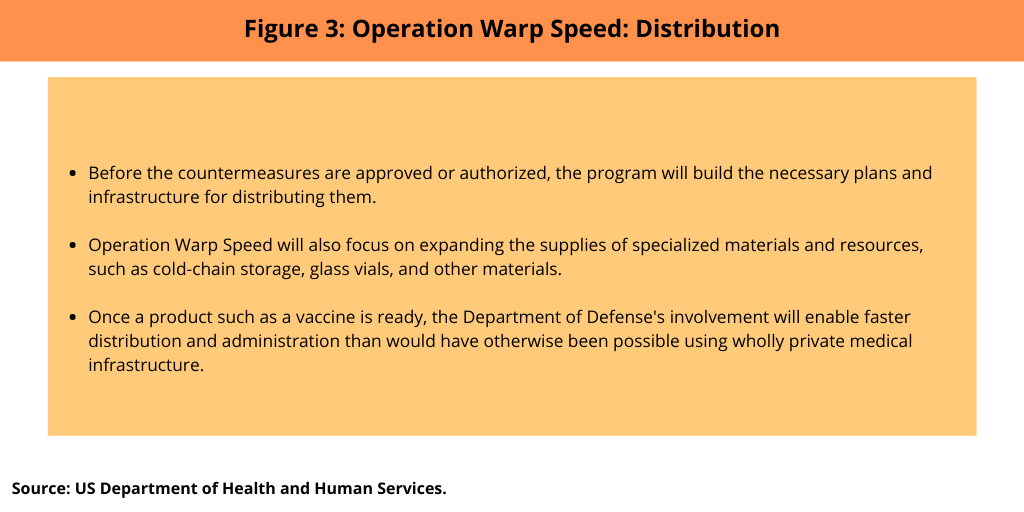
The second area of focus is manufacturing (see Figure 2). The US federal government is making investments in manufacturing and distribution at its own risk much earlier than usual, giving firms confidence that they can invest “aggressively” in development of countermeasures according to the HHS. Manufacturing capacity for selected candidates, including the three to five selected vaccines, will be advanced while they are still in development, rather than scaled up after approval or authorization, as is the case with traditional development timelines. The manufacturing capacity developed will be used, to the extent practicable, for whatever vaccine is eventually successful, regardless of which firms have developed the capacity according to the HHS.
The third area of focus for Operation Warp Speed is distribution (see Figure 3). Before the countermeasures are approved or authorized, the program will build the necessary plans and infrastructure for distributing them, especially the effort that will be necessary to deliver a vaccine to hundreds of millions of people in a timely manner, according to the HHS. This will involve expanding the supplies of specialized materials and resources, such as cold-chain storage, glass vials, and other materials, that can be necessary for distribution of countermeasures. Once a product such as a vaccine is ready, the Department of Defense’s involvement will enable faster distribution and administration than would have otherwise been possible using wholly private medical infrastructure, according to the HHS.

